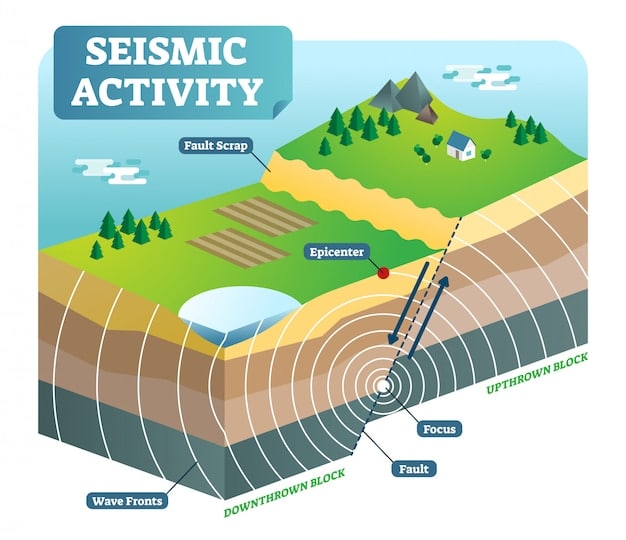US Energy Dept Invests in Geothermal: Unearthing the Future

US Department of Energy Invests $50 Million in Advanced Geothermal Systems: What’s Next? The U.S. Department of Energy’s \$50 million investment in Enhanced Geothermal Systems (EGS) aims to unlock vast, untapped geothermal resources, driving innovation in renewable energy technologies and paving the way for a sustainable energy future.
The **US Department of Energy Invests $50 Million in Advanced Geothermal Systems: What’s Next?** This financial boost could revolutionize the energy sector and reshape how the United States harnesses the Earth’s natural heat. Let’s delve into what this means for the future.
Unlocking Earth’s Potential: DOE’s Geothermal Investment
Enhanced Geothermal Systems (EGS) represent a frontier in renewable energy. This technology goes beyond traditional geothermal resources, tapping into the Earth’s vast reservoirs of heat located deep underground. With a \$50 million investment, the Department of Energy (DOE) is aiming to make EGS a viable and widespread energy source.
The investment focuses on research, development, and demonstration projects. These initiatives seek to overcome the technical barriers currently hindering the widespread adoption of EGS, such as drilling techniques, reservoir characterization, and sustainable resource management. The potential impact is enormous.
What are Enhanced Geothermal Systems (EGS)?
EGS is an innovative approach to geothermal energy extraction. It involves creating or enhancing pathways for water to circulate through hot, dry rocks deep beneath the Earth’s surface. This heated water is then brought to the surface, where it can be used to generate electricity or for direct heating purposes.
- Conventional geothermal energy relies on naturally occurring hydrothermal resources, which are limited in availability.
- EGS, on the other hand, can access geothermal resources virtually anywhere, significantly expanding the potential for geothermal energy production.
- The process involves drilling deep wells into hot, dry rocks and injecting high-pressure water to fracture the rock and create permeability.
- This allows water to circulate through the hot rock, heat up, and then be extracted through another well.
EGS could provide a clean, reliable, and baseload power source, reducing our dependence on fossil fuels and mitigating climate change. The initial investment is just the first step in a much larger energy transition.

The Goals of the Department of Energy’s Investment
The specific goals of the DOE’s \$50 million investment are multifaceted, addressing various aspects of EGS technology and deployment. By strategically allocating funds, the DOE aims to accelerate the development and adoption of geothermal energy across the United States.
The DOE hopes to significantly reduce our nation’s dependence on fossil fuels, furthering environmental sustainability and helping combat issues related to global climate change. This investment marks a significant step towards a greener future.
Advancing Geothermal Technology
A key objective is to advance the technological readiness of EGS. This includes improving drilling techniques to reduce costs and increase efficiency, developing better reservoir characterization methods to accurately assess geothermal resources, and enhancing power plant technologies for more efficient energy conversion.
All of the funds are channeled towards fostering collaboration and innovation. By supporting collaborative research projects and public-private partnerships, the DOE aims to foster a dynamic ecosystem of innovation. This way, the geothermal industry can evolve and accelerate the deployment of EGS.
- Reducing Drilling Costs: Innovative drilling technologies can lower capital expenditures.
- Improving Reservoir Characterization: Advanced techniques can accurately assess geothermal resources.
- Boosting Energy Conversion Efficiency: Enhanced power plant technologies improve the utilization of extracted heat.
By focusing on these key areas, the DOE’s investment sets the stage for a geothermal energy revolution. The potential benefits extend beyond energy production, creating jobs and economic opportunities in the renewable energy sector.
Projects Receiving Funding: Overview
The \$50 million investment will be distributed among various projects, each focusing on different aspects of Enhanced Geothermal Systems. These projects can target specific challenges and opportunities within the geothermal sector. Together, they form a comprehensive approach to advancing EGS technology.
The allocation of funds enables the most promising and impactful initiatives to thrive, while also fostering collaboration between research institutions, private companies, and government agencies. This has become a catalyst for innovation and speeds up the transition to renewable energy.
Detailed Project Descriptions
The projects selected for funding encompass a wide range of activities. This may include field experiments to test new drilling techniques, laboratory studies to understand reservoir behavior, and the development of advanced monitoring systems to ensure sustainable resource management.
One important consideration is the level of environmental sustainability. The DOE investment prioritizes projects that minimize environmental impact and seek to maximize the long-term viability of geothermal resources. This underscores the agency’s commitment to responsible energy development.
- Field experiments focused on advanced drilling techniques.
- Laboratory studies of geothermal reservoir behavior.
- Development of advanced monitoring systems.
The results from these funded projects will be instrumental in informing future research and development efforts. The collaboration between different projects can accelerate the pace of innovation, thus further expediting the overall development of EGS technology.
Environmental and Economic Impacts
The DOE’s investment in Enhanced Geothermal Systems brings about substantial environmental and economic benefits. It is geared towards fostering sustainability, reducing our carbon footprint and driving economic growth in renewable energy.
By transitioning to a cleaner energy future, it is important to improve public health, reduce pollution, and enhance energy security. The impact of this transition is likely to be felt across multiple sectors, not just the energy sector alone.
Economic Growth and Job Creation
The development and deployment of EGS technologies can create numerous jobs in manufacturing, construction, engineering, and research. The geothermal industry can stimulate economic growth in rural areas where geothermal resources are abundant.
The private sector is likely to contribute to the expansion of the geothermal industry. This fosters a competitive market, driving innovation and reducing costs, while ensuring long-term economic viability and resilience.

- Job creation in manufacturing and construction.
- Economic stimulus in rural communities with geothermal resources.
- Attracting private sector investments in geothermal energy.
EGS projects can provide affordable and reliable energy to communities and businesses. This lowers costs leading to increased economic productivity. The economic benefits can be significant, thus contributing to the overall prosperity and competitiveness of the nation.
Challenges and Future Directions for EGS
Despite the significant potential of Enhanced Geothermal Systems, several challenges need to be addressed to ensure its widespread deployment. These challenges are technical, economic, and regulatory in nature, requiring coordinated efforts to overcome.
The geothermal industry has a future marked by growth and innovation. This can ensure that EGS becomes a key component of global energy mix. The DOE’s commitment is essential to driving this important industry.
Overcoming Technical Barriers
One of the primary challenges is the high cost associated with drilling deep wells and creating artificial fractures in hot, dry rocks. The development of more efficient and cost-effective drilling technologies is essential to reduce capital expenditures.
By investing in collaborative research, the DOE can work towards overcoming the technical barriers and promote sustainability. This ensures future research and development efforts will accelerate the pace of innovation in the sector.
- Reducing the cost of drilling deep wells.
- Improving fracture creation and management.
- Developing advanced reservoir modeling techniques.
Addressing these challenges is critical to unlocking the full potential of EGS. Innovation, strategic partnerships, and government support are crucial for advancing EGS technologies and ensuring their long-term success in the renewable energy landscape.
Policy and Regulatory Support
Government support, including policies and regulations, plays a crucial role in fostering the development and deployment of Enhanced Geothermal Systems. Clear and supportive policies set a level playing field, helping attract investment and accelerate the adoption of EGS technologies.
The DOE works closely with policymakers to promote geothermal energy, ensure that the regulatory landscape is conducive to geothermal development, and align policies with broader energy and environmental goals. This collaboration is key to driving the industry.
Incentives and Regulations
The government can offer a range of incentives, such as tax credits, grants, and loan guarantees, to encourage investment in EGS projects. Regulations relating to environmental protection, resource management, and permitting processes can impact the viability of EGS projects.
By streamlining regulatory processes and providing clear guidelines, the DOE can reduce uncertainty and enable projects to move forward more efficiently. This sends a positive signal to investors, encouraging greater participation in the geothermal sector.
| Key Aspect | Brief Description |
|---|---|
| 💰 Investment | \$50 million allocated by DOE to enhance geothermal tech. |
| 🌍 EGS | Tapping into earth’s heat by creating subsurface water circulation. |
| ✅ Goals | Advancing tech, reducing costs, expanding geothermal access. |
| 🌱 Impact | Environmental sustainability and economic growth. |
FAQ
▼
EGS are engineered reservoirs created to extract heat from hot, dry rocks deep underground. They involve injecting water into fractured rocks to create a subsurface heat exchanger, which is then tapped for energy.
▼
The DOE is investing in EGS to unlock vast geothermal resources that are currently untapped. By advancing EGS technology, the DOE aims to provide a clean, reliable, and domestic energy source to promote energy security.
▼
Conventional geothermal systems rely on naturally occurring hydrothermal resources, while EGS creates artificial reservoirs to extract heat from otherwise non-productive rock formations. EGS can get to untapped resources.
▼
EGS boasts minimal emissions. It reduces reliance on fossil fuels. It also offers a sustainable energy source with a small footprint, thus supporting the reduction of greenhouse gas emissions. The impact is significant.
▼
The potential challenges include high initial costs. The geothermal sector requires advanced drilling and reservoir management techniques. Induced seismicity is also possible, thus requiring careful monitoring and mitigation strategies with the right investments.
Conclusion
The US Department of Energy’s \$50 million investment in Advanced Geothermal Systems highlights a commitment to renewable energy innovation. By overcoming technological challenges, fostering economic growth and prioritizing sustainability, EGS has the potential to transform the energy landscape, thereby improving our nation’s energy future.





